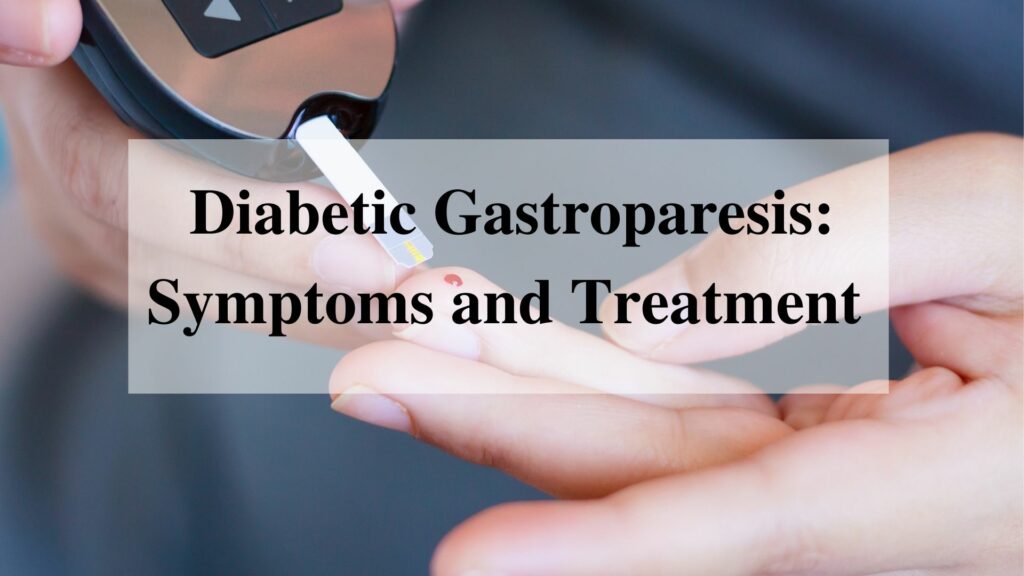Diabetic gastroparesis is a diabetic complication that affects the digestion of food. It can cause nausea, vomiting, bloating, and abdominal pain. In this article, we will discuss diabetic gastroparesis symptoms as well as treatments to help improve your quality of life.
In today’s society where people are living longer with diabetes, diabetic gastroparesis has been on the rise in recent years too. If you have been experiencing these symptoms for a while now it may be time to see a doctor or gastroenterologist about getting diagnosed and treated.
Contents
What Exactly is Diabetic Gastroparesis?
diabetic gastroparesis is a condition that affects the digestive system in diabetics, making it difficult to digest food.
During digestion, the stomach gets smaller so that food can fit in it. This helps break down the food. Gastroparesis is when the stomach does not get smaller to help you digest your food, which may make it hard for you to digest your food.
Gastroparesis is a disease that causes the stomach to not work. It can be caused by diabetes because it affects the nervous system.
Nerve damage caused by types 1 and 2 diabetes is common. The vagus nerve, which may be damaged by diabetes, controls stomach food movement.
The vagus nerve controls the muscles in the stomach and other digestive tract components when they are not functioning appropriately. When this happens, food does not move through the digestive system as quickly.
Delayed gastric emptying is another name for gastroparesis.
Symptoms of Diabetic Gastroparesis
Gastroparesis is a condition in which the stomach can no longer empty normally. People who suffer from gastroparesis may experience any number of symptoms and indications, some of which are listed below:
- nausea and vomiting, especially of undigested food
- Heartburn
- Fullness after eating little
- Hunger loss
- Bloating
- Unwanted weight loss
- Unstable blood sugar levels
- Gastroesophageal reflux
- Stomach spasms
Depending on the damage to the vagus nerve, a long cranial nerve that extends from the brainstem to the abdominal organs, including those of the digestive tract, gastroparesis symptoms may be minor or severe.
Symptoms can appear at any moment and are most prevalent following a high-fiber or high-fat meal, which takes a long time to digest.
If you feel any of the symptoms mentioned above, call your doctor immediately.
Causes of Diabetic Gastroparesis

Gastroparesis can be caused by several things, including a condition that damages the vagus nerve, which controls stomach muscles.
The vagus nerve helps control the complicated processes in your digestive system, including telling your stomach muscles to contract and push food into the small intestine.
A damaged vagus nerve can’t send messages to your stomach muscles as it should. As a result, food might remain in your stomach longer rather than moving into your small intestine to be digested.
Diseases, such as diabetes, or stomach or small intestine surgery can damage the vagus nerve and its branches.
Risk Factors of Diabetic Gastroparesis
Gastroparesis is a disorder that affects the stomach and intestines. It’s more common in women with diabetes, especially those who have had abdominal operations or suffer from an eating problem.
Other than diabetes, other illnesses and conditions can induce gastropareses, such as viral infections and acid reflux disease.
Gastroparesis can be caused by a variety of illnesses, some of which are listed below.
- Parkinson’s disease
- Chronic pancreatitis
- Cystic fibrosis
- Kidney disease
- Turner syndrome
Diabetic gastroparesis can have a variety of causes, although some are more common than others. Even after extensive testing, many cases have no known cause.
Complications in Diabetic Gastroparesis
It is more difficult for someone with diabetes to manage their blood sugar levels if they have gastroparesis.
It’s quite common for a stomach with gastroparesis to take a long time to empty food into the intestine for absorption. Other times, the stomach may quickly pass what it is eating.
Because diabetes is unpredictable, it’s difficult for someone with the disease to know when to administer insulin. Blood sugar levels can become too high or too low at times as a result of this unpredictability.
When blood sugar levels are too high it puts a person with diabetes at greater risk of the following:
- Kidney damage
- Eye damage, such as retinopathy and cataracts
- Heart disease
- Foot complications that can lead to amputation
- Neuropathy
- Ketoacidosis
When blood sugar levels fall too low in a person with diabetes, he or she can develop the following problems:
- Shakiness
- Diabetic coma from low blood sugar
- Loss of consciousness
- Seizures
- Other complications from diabetic gastroparesis can include:
- Malnutrition
- Bacterial infections
- Indigestible masses, known as bezoars, can cause stomach obstruction
- Electrolyte imbalance
- Tears in the esophagus from chronic vomiting
- Inflammation of the esophagus that may cause difficulty swallowing
Gastroparesis is a long-term illness that can be quite distressing.
It’s exhausting to go through the process of making dietary changes and attempting to manage blood sugar levels when you’re feeling sick and nauseated to the point of vomiting. Those with gastroparesis frequently feel angry and down.
Diagnosis of Diabetic Gastroparesis

If a physician suspects diabetes gastroparesis, he or she will usually request one or more of the following tests to confirm the diagnosis.
Barium X-ray
A barium X-ray is typically the first diagnostic test for gastroparesis. A person will fast for 12 hours, drink a barium solution, and then undergo an abdominal X-ray to get a barium X-ray. The stomach will be coated with barium to make it visible on X-ray as a result.
A person who has fasted typically has an empty stomach before this test. Someone with gastroparesis, on the other hand, may still have food in their stomach.
Barium beefsteak test
A barium beefsteak test is performed when someone consumes food that has been laced with barium. During the meal’s digestion, the person will undergo imaging tests. A physician will use imaging to observe how long it takes for food to leave the stomach.
Radioisotope gastric-emptying scan
The radioisotope gastric-emptying scan is a test that uses a person’s stomach to absorb a radioactive substance before they have an imaging examination.
Gastric manometry
The muscles in the stomach are tested during gastric manometry. A doctor will insert a thin tube into a person’s mouth and down their throat to conduct a gastric manometry. The device within the tube measures the activity of the stomach as it digests food. The results reveal how effectively the stomach is working.
Other tests
Additionally, a physician may order any of the following tests if they suspect diabetic gastroparesis:
- Blood tests to look for nutritional deficiencies and electrolyte imbalances, which are common in gastroparesis.
- To rule out gallbladder problems, kidney disease, or pancreatitis as causes, imaging of the gallbladder, kidneys, and pancreas should be done.
- An endoscopy is a procedure performed through the mouth that uses a thin tube with a camera on the end to examine the stomach’s structure.
Treatment
Although there is no cure, you can control gastroparesis and its symptoms.
Controlling your blood sugar levels is a good idea. Check with your doctor about whether you should alter the time and frequency of your insulin usage, and monitor your sugar levels more frequently.
If you have gastroparesis, eating while sick often causes nausea and vomiting. You can minimize or stop sickness-induced nausea and vomiting by eating small meals frequently throughout the day and night.
Also, consult with your doctor about whether you should change medications that might exacerbate gastroparesis like antidepressants, high blood pressure medicines
Some people may benefit from medicines to a certain extent:
- The most common cause of motion sickness is over-the-counter antihistamine medication (dimenhydrinate, commonly known as Dramamine). It also helps prevent nausea and vomiting.
- Ephedrine and Ditropan are medications that help to enhance digestion by relaxing the smooth muscle of your stomach. Managing difficulties in your upper digestive system linked to gastropareses, such as nausea and vomiting, is Domperidone (Motilium).
- Erythromycin, a type of antibiotic, aids in the removal of food from your stomach.
- Metoclopramide (Reglan) activates your stomach muscles, which aids in the removal of food from your body. It can also prevent nausea and vomiting.
- Zofran (ondansetron) is a drug that inhibits chemicals in your brain and stomach, which cause nausea and vomiting.
- Prochlorperazine (Compazine) is a medicine that helps with nausea and vomiting.
A surgically implanted device sends out brief, low-energy pulses to your stomach to help you feel better after surgery by stimulating your stomach with a technique known as gastric electrical stimulation.
Diet Changes

When you have diabetes, one of the most effective ways to manage gastroparesis symptoms is to vary your eating schedule. Instead of three meals each day, eat six small meals instead. You won’t feel as full since there will be less food in your stomach. The food will also be easier to pass through your body.
Furthermore, pay attention to the food’s texture. Liquids and foods that are easy to digest are a fantastic idea. Choose applesauce instead of whole apples, for example.
Avoid foods that are rich in fat, which might cause your digestion to slow down. Fiber is another consideration since it takes longer for the body to digest.
Conclusion
When you have diabetes and experience gastroparesis, it can be difficult to maintain a diet. You may need more than just insulin treatment for your condition; talk to your doctor about the best way to manage diabetic gastroparesis so that you can live with this chronic illness without too much trouble. Look into gastric pacing as well as appetite stimulants such as metoclopramide or domperidone which are available by prescription from your physician. It’s important not only to treat the symptoms of diabetic gastroparesis but also to prevent them in order to see better results. A healthy lifestyle is always key when dealing with any type of chronic disease like diabetes and we hope these tips help make living easier.
Do you want to get rid of diabetes? Join our online diabetes consultation program and reverse your Diabetes naturally through lifestyle changes such as a Personalized Diet plan, Exercise, dieticians, and health coaches.


